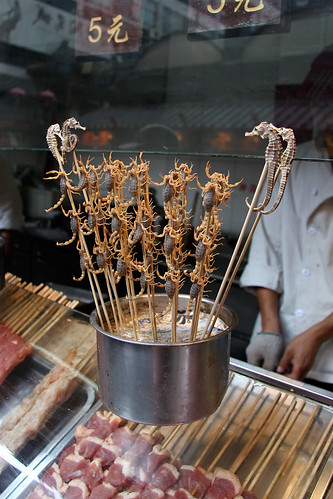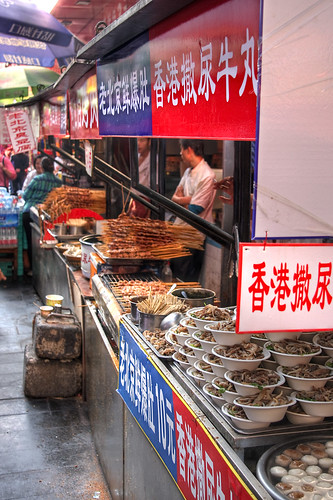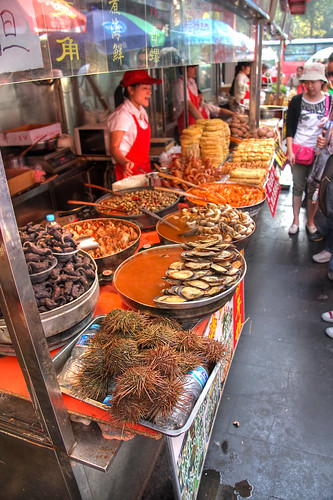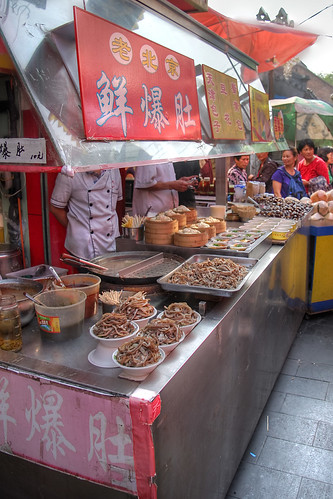The importance of food in China is well pictured in one of their greetings, which translates to “have you eaten?”. Eating opportunities are all over the city, and even if there is no restaurant or food stand nearby, there will be a trailer or grill at the corner serving cooked, roasted or raw delicacies. I’m open to any new experiences so I wanted to try everything the locals eat too. This article sums up my food related adventures in Beijing.
Breakfast, lunch and dinner consist of similar dishes because the Chinese eat spicy and salty dishes for breakfast too. Although I wasn’t used to eat hot and spicy food in the morning, I easily adapted to the local habits. Of course, the Chinese know about the differences between cuisines and respect the western taste, so in hotels you usually get corn flakes, some toast, jams from Germany and butter from New-Zealand. In general, the coffee tastes very unusual, it is actually grey instead of brown so it’s possibly made from some kind of grain. Although it is quite enjoyable if it is cooked strong enough, it still doesn’t have much in common with real coffee. Addicts should rather look for international shops like Starbucks or Costa, because only they serve real stuff – at pretty expensive western rates. The traditional warm soy milk served for breakfast tastes unusual too, sometimes they even serve it as a custard. I was surprised by the freshly prepared Lángos each morning, which is considered a typical Hungarian food in Europe. The Chinese eat it on its own or stuffed and rolled with various spicy and salty dishes.
Beijing has as many restaurants as there are stars in the night sky. Or probably they have even more, if you count the street vendors preparing chestnuts or sweet potato directly in the hot and smoking charcoal. Part of the restaurants have big round tables with a rotatable plate in the middle. The menu shows most dishes along with photos, so ordering is no problem even if there is no separate English menu. Usually many dishes are ordered at once and all of them are placed on the central plate in the order they get ready. Afterwards everybody uses their own chopsticks to pick from the dishes in the middle whatever and how much they like, which creates a quite familiar atmosphere. The Chinese tend to order a lot more than they actually plan to eat. This is especially true if you are invited by someone. Not leaving any food in the middle of the table means that the inviting person was not generous enough, which is simply unthinkable. Smaller restaurants usually have square tables without a rotatable central plate, though the different dishes still get served wherever there is some place left on the table. I really enjoyed this form of dinner, because it is a lot more communicative, you can explore different foods and you can eat as much as you like.
In Germany if you go out with a group of people, they usually pay separately for their drinks and foods. In China this habit is completely unknown. Sometimes you might even see and hear a (friendly) argument between two or three guests on who can finally pay the bill for the whole group. There is no clear rule for tips: you might give some or not, there won’t be any conflict or disappointment. Usually the bill is not served at the table. For paying you have to stand up and go to the desk located somewhere near the entrance. The waiters also first tell the orders the cashier sitting behind the desk and only then they take the orders to the kitchen. Eating out in Beijing is on average very cheap. You can eat your fill for about 50 to 60 yuan (about 9 dollars) and this already includes two beer.
When ordering food from the menu you should be aware that Chinese don’t really have different courses. Each dish gets served as soon as it is ready. So if you would like to eat some fried banana or nougat filled rice dough for dessert, you should order it later separately. Although, desserts aren’t common in general. Among the dishes you’ll always find different kinds of cabbage, I especially enjoyed the one which looked like a crossbreed of chard and celery. Everything is cooked in a way that you can easily eat it with chopsticks or a spoon. Every restaurant we visited served really fresh food and vegetables were served joyfully crispy. Also the quality of soy sauce was much better than the crap you get in Europe.
I especially loved eating fish in restaurants because they usually keep them alive and kill them only to order. Sometimes they even show you the still wriggling fish table-side whether it will be okay for you or if they should get another one. This freshness always resulted in a very delicate taste and wonderful texture. In Europe fish is usually cut open from its stomach, in China I observed that all restaurants cut their fish from the back. Only the backbone was removed and all other fish bones were left in the meat. This was very similar in chicken dishes too, where the roasted chicken was simply cut in pieces along with all bones. So while eating the chicken you had to chew off the meat from the bones and place the bones back on your plate using the chopsticks.
While walking around in Beijing there are several snacks offered by food stands on the street. Food on skewers seems to be especially popular, you can select from a huge ranging from sausages and grilled meats to seahorses, scorpions and pupas. The scorpions are especially spectacular, because they are skewered still alive so they are still moving around while waiting for customers. I tried both the scorpions and the silkworm pupas. Scorpions are served deep fried and are one of the most crispy experiences I ever encountered, although it tasted only like the oil it was fried in. The pupas were actually quite nice, not as crispy as the scorpions, but with a soft interior. It reminded me of dry potato puree with peanut flavor. Recently the WHO recommended for the western world to start eating insects as protein source. So if this would be the case soon, I don’t think I would have any problems eating pupas.
At food markets steamed wheat or rice dough filled with various mysterious stuff is served too. The version with rice dough is a kind of a big ravioli with thick pasta. Fresh rice noodles are a pleasant fast food too, which is usually served in a hot spicy broth or a fermented sauce with fresh celery and scallions. Instead of cutting the noodles, the Chinese use a traditional technique with wavy moves for lengthening the dough. Afterwards the dough is folded in half and the lengthening procedure is repeated until the noodles get about 0,5cm thin. Implicitly, the noodles get very long, so it is common to bite off the noodles when you slurped enough. During my stay in autumn the Chinese were harvesting corn, so freshly cooked sweet corn was sold at almost all corners. It was interesting to observe that the corn was cooked and sold still covered by its leaves, probably because the leaves kept it hot for a longer time. Also the habits regarding eating corn were interesting to see, because Chinese usually peel the corn like a banana and eat it from top to bottom and not from left to right, as it is usually eaten in Europe.
It is impossible to give a complete overview of the Beijing restaurant scene, because there are so many and they are very diverse. Generally, I would recommend to visit only restaurants where there are no western people sitting inside and absolutely nobody speaks any English. Ordering is no problem, because the menus show the photos of the dishes, so just by pointing on what you would like, you can easily communicate with your waiter. Only one sentence might be important to have noted on a piece of paper written in Chinese saying “2 beer please”. I tried several times to pronounce this correctly in Mandarin, but unfortunately I was never understood.
Besides the Wangfujing Snack Street, I enjoyed the Guang’anmen Food Street too, where many restaurants specialize in Szechuanese style cooking. Szechuanese food is famous for its spicy hot dishes while still nicely adding fruity, sweet, sour and salty notes. I tried a wonderful steamed fish, half of it covered by enormous amounts of fresh fruity red chilis (they weren’t peppery at all) and the other half covered with a green tabasco like sour and spicy mash. Our most favorite restaurant during the week was a little bit rundown looking place about 1km from our hotel (or in Beijing terms I should say “pretty close”). The Bao Qin Restaurant specialized in Dai food. Every single dish we got served was impeccably delicious. I never had such a clear tasting fried grated potato with a perfect crust. Also simple food like rice with bell peppers was just tremendous. The rice soaked up the freshness of the bell pepper, I could have eaten this dish all day long on its own. My favorites were the fried pork skins and the Dai fish soup. From the pork skins they scraped down all fatty and gelatinous parts, so it was really only the skin, which was quickly fried and served wonderful crispy. The Dai fish soup reminded me of a Hungarian fish soup served with sauerkraut. The sauerkraut was replaced by a similarly sour local cabbage and the fish soup contained besides fresh fish, garlic, paprika and chili a lot of fresh ginger and Szechuanese pepper too. The restaurant has a very nice website where they show pictures of some of their dishes. If you happen to be near the Renmin University, this restaurant is well worth a visit.
During the week I really enjoyed the local Chinese food in Beijing. The saying, that food in China is different from Chinese food in Europe, is actually true. Every restaurant we visited used fresh ingredients and we encountered the buffet style self-service only at our hotel, although the food there was prepared fresh too. It’s true that some dishes are hot and spicy, but this is always paired with a pleasant fresh fruity taste. If you don’t like spicy dishes at all, avoiding them is no problem either. At last you can also find European restaurants (e.g. Italian, French, German etc.) in Beijing, but it would be a sin not to try all the wonderful local specialties.





Whoa! The food looks pretty exotic I must say. One thing that I’m most “afraid” about going to China is their food… I hear that they have really good food but also really “interesting” food, if you know what I mean…. 🙂
Not all food was as exotic as the ones in the photos in this post, so don’t be scared – most of the food is pretty usual and not exotic at all. Although jelly-like consistencies seem to be quite popular in China, but they are easy to avoid too if you don’t like them. But if you are already in China, it’s worth to try also some “interesting” food 😉